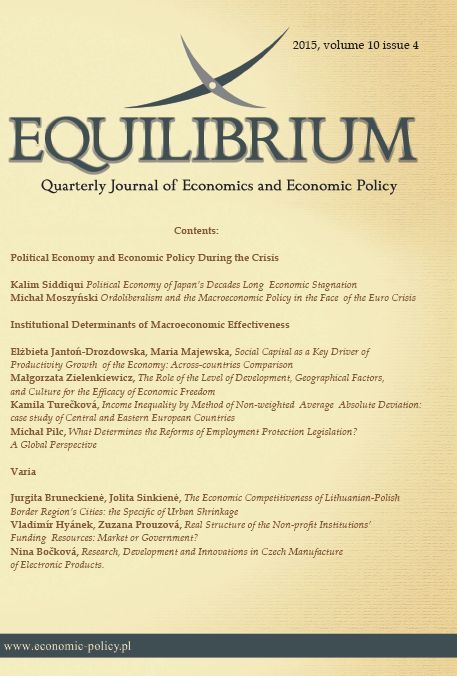Income inequality by method of non-weighted average absolute deviation: case study of Central and Eastern European countries
DOI:
https://doi.org/10.12775/EQUIL.2015.037Keywords:
income inequality, index, comparison, method of non-weighted average absolute deviationAbstract
The presented article uses the method of non-weighted average absolute deviation for expressing income inequality in 11 selected Central and Eastern European Countries. Specifically, the analysis of income inequality is done for Poland, the Czech Republic, the Slovak Republic, Austria, Slovenia, Hungary, Romania, Bulgaria, Latvia, Lithuania and Estonia. Based on the determination of income inequality in the article an analysis is made concerning the development of income inequality, including the subsequent inter-regional comparison in the context of the degree of income inequality in a given human society and economy. The text of this article is organized in 4 parts, after Introduction follows the analytic chapter where, primarily, the method of non-weighted average absolute deviation is explained. The third part contains the empirical analysis of income inequality, and the Conclusion highlights some major conclusions of detailed analysis made in Chapter 3. The analysis of income distribution of 11 European households between years 2005-2013 and its order is made in deciles basing on empirical data from the Statistics on Living Conditions and Welfare published by Eurostat.
Downloads
References
Babu, G. J., & Rao, C. R. (1992). Expansions for statistics involving the mean absolute deviations. Annals of the institute of statistical mathematics, 44(2). http://dx.doi.org/10.1007/BF00058648.
Daisaka, H., Furusawa, T. & Ynagawa, N. (2014). Globalization, financial development and income inequality. Pacific economic review, 19(5). DOI: http://dx.doi.org/10.1111/1468-0106.12086.
Dalton, H. (1920). The measurement of the inequality of incomes. Retrieved from http://www.ophi.org.uk/wp-content/uploads/Dalton-1920.pdf (28.01.2015).
Dewilde, C., & Lancee, B. (2013). Income inequality and access to housing in Europe. European sociological review, 29(6). DOI: http://dx.doi.org/10. 1093/esr/ jct009.
EUROSTAT. (2015). Category: Living condition glossary. Retrieved from http://epp.eurostat.ec.europa.eu/statistics_explained/index.php/Category: Living _conditions_glossar (28.01.2015).
EUROSTAT. (2015). Statistics: Income distribution and monetary poverty. Retrieved from http://ec.europa.eu/eurostat/data/database (29.01.2015).
Lapáček, M. (2007). Příjmová nerovnost a ekvivalenční stupnice. Retrieved from http://nf.vse.cz/download/veda/workshops/inequality.pdf (29.01.2015).
Lemieux, T. (2008). The changing nature of wage inequality. Journal of Population Economic, 21(1). DOI: 10.1007/s00148-007-0169-0.
Litchfield, J. A. (1999). Inequality: Methods and Tools. Text for World Bank?s Web Site on Inequality, Poverty, and Socio-economic Performance. Retrieved from http://www.worldbank.org/poverty/inequal/index.htm (23.01.2015).
Novotny, J. (2007). On the measurement of regional inequality: does spatial dimension of income inequality matter?. Annals of regional science, 41(3). DOI: http://dx.doi.org/10.1007/s00168-007-0113-y.
Paredes, D., Iturra, V. & Lufin, M. (2012). A further step to understand income inequality in Chile: A decomposition using three-stages nested Theil index decomposition method. Retrieved from http://www.researchgate.net/publi cation/235256577_A_further_step_to_understand_income_inequality_in_Chile_A_decomposition_using_three-stages_nested_Theil_index_decomposition_ method (10.02.2015).
Peng, B. C. (2014). Status and income inequality in a knowledge economy. Journal of economic inequality, 12(4). DOI: http://dx.doi.org/10.1007/s10888-014-9274-y.
Rosen, S. (1981). The economics of superstars. American Economic Review, 71(5).
Samuelson, P. A. & Nordhaus W. D. (2010). Economics. New York: McGraw-Hill.
Schutz, R. (1951). On the Measurement of Income Inequality. American Economic Review, 41(1).
Stiglitz, J. E. (1997). Ekonomie veřejného sektoru. Praha: Grada.
Tuleja, P. (2009). Možnosti měření regionálních disparit ? nový pohled. Retrieved from http://disparity.idealnihosting.cz/regdis_2008/pdf/13%20regdis_2008.pdf (05.02.2015).
Turečková, K. & Kotlánová E. (2014a). Income inequality in the Czech Republic and Slovak Republic. In Proceedings of the International Workshop Ten years of Membership of the Czech and Slovak Republic in the European Union. Karviná: OPF SU Karviná.
Turečková, K. & Kotlánová E. (2014b). Poverty Analysis and Measuring Income Inequality in Czech Republic. In Mathematical methods in Economics MME 2014 ? Conference Proceeding. Olomouc: Faculty of Science, Palacký University.
Turečková, K. & Kotlánová E. (2015). Method of Non-weighted Average Absolute Deviation in Context of Measuring Income Inequality by Gini Coefficient: case study of Visegrad group countries. In Conference Proceedings: 33rd International Conference Mathematical Methods 2015. Plzeň: University of West Bohemia.
Turečková, K. (2015). Measurement of income inequality by method of non-weighted average absolute deviation: Case of South European Countries. In Proceedings of the 12th International Conference Liberec Economic Forum 2015. Liberec: TU Liberec.
Willianson, J. (1965). Regional inequality and the process of national development. Economic Development and Cultural change 4.
Wolff, E. N. (2009). Poverty and income distribution. 2nd Ed. Chichester, UK: Wiley-Blackwell.






